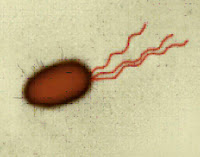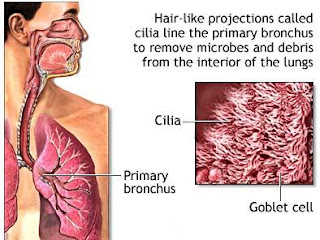Cilia and
Flagella are fine hair like cytoplasmic processes arising from the free margins
of the cell. These are structurally almost similar structures. However, they
differ in size, number and mode of beating.
Except for sperm, the cilia in mammalian systems are not organelles of locomotion. But their effect is the same, that is, to move the environment with respect to the cell surface.
The flagella occur in the protozoans of the class Flagellata, choanocyte of the sponges, spermatozoa of the metazoan and among plants in the algae and gamete cells.
Structure of Cilia and Flagella
Immotile Cilia Syndrome (Kartagenres’s Syndrome):
Distribution of the Cilia and Flagella
The Cilia occur
in the protozoans of the class ciliate and members of other classes and
ciliated epithelium of the metazoan. The cilia may occur on external body
surface and may help in the locomotion of such animals as the larvae of certain
platyhelminthes, echinodermata, mollusc and annelid. The nematode worms and
arthropods have no cilia.
 |
| Flagella |
Except for sperm, the cilia in mammalian systems are not organelles of locomotion. But their effect is the same, that is, to move the environment with respect to the cell surface.
The flagella occur in the protozoans of the class Flagellata, choanocyte of the sponges, spermatozoa of the metazoan and among plants in the algae and gamete cells.
Structure of Cilia and Flagella
Both the cilia
and flagella arise from a small granular structure called the basal body. The
cilia and flagella are covered by a unit membrane which is an extension of the
plasma membrane of the cell. They have a central filament called axoneme. The
axoneme is formed of eleven microtubules. Two of them are central singlets
(single microtubules) and nine peripheral doublets (pairs of microtubules).
This gives a 9+2 microtubular arrangement. The axoneme get embedded in a fluid
matrix and surrounded by the unit membrane. The sliding of the microtubules of
the axoneme is responsible for the movement of cilia and flagella.
The axoneme of
cilia has a variety of proteins such as α and β tubulins in the microtubules, dynein (the microtubule ATP ase), nexin and others (Table 1).
Table 1: Major protein
structures of the axoneme of the cilia and Flagella
|
||
Serial No
|
Axoneme component
|
Function
|
1
|
Tubulin (8 nm)
|
Principal
component of microtubules
|
2
|
Dynein (24 nm)
|
Project from
microtubule doublets and interact with adjacent doublets to produce bending.
|
3
|
Nexin link (86
nm)
|
Hold adjacent
microtubule doublets together.
|
4
|
Radial spokes
(29 nm)
|
Extend from
each of the nine outer doublets inward to the central pair.
|
5
|
Sheath projections (14 nm)
|
Project as a
series of side arms from the central pair of microtubules; together with the
radial spokes these regulate the form of the ciliary beat
|
The ciliary beat consists of two strokes: Power stroke and Recovery stroke.
Four types of
ciliary movements have been recognized which are as follows:
- The Pendulus ciliary movement
- The unciform ciliary movement
- The infundibuliform ciliary movement:
- The undulant movement
Cilia and Flagella
Table 2: Difference
between Cilia and Flagella
|
||
Serial No
|
Cilia
|
Flagella
|
1
|
Numerous
|
Less in number
|
2
|
Short and hair
like organelle (10µ)
|
Long whip like
organelle (150μ)
|
3
|
Occur
throughout the cell surface
|
Presence at
one end
|
4
|
Beat in coordination
|
Beat
independently
|
5
|
Show sweeping
movement or pendular stroke
|
Undulatory
movement
|
Immotile Cilia Syndrome (Kartagenres’s Syndrome):
Cilary motion
can be affected by many deficiencies in the protein composition of the
organelle. For example, in immotile cilia syndrome, a condition characterized
by severe respiratory difficulty and male sterility, the underlying genetic
defect is the absence of inner and outer dynein arms on the peripheral doublets
of both cilia and flagella. The symptoms of this syndrome result from the
immobility of cilia in the respiratory tract and of the flagella in the sperm.
In Chlamydomonas several mutational defects
have been studied in the axoneme of flagellum which may lead to paralysis of
the flagellar function.
- Serves as locomotory organs in ciliates, flagellates and other invertebrates.
- Help in capturing food in many protozoans and some metazoans.
- Helping in circulation, respiration and excretion in many organisms.
- The eggs of amphibians and mammals are driven out from the oviduct by the aid of vibratile cilia of the latter.
Thus, the cilia
and flagella serve many physiological processes of the cell, such as
locomotion, alimentation, circulation, respiration, excretion and perception of
sense.
Tags:
9+2 arrangement
Bacterial Flagella
cilia and Flagella
Cilia vs Flagella
Immotile Cilia Syndrome
Kartagenres’s Syndrome
prokaryotic flagella vs eukaryotic flagella
Structure of Cilia
Tubulin


